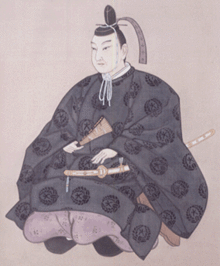- Ōkubo Tadazane
-
In this Japanese name, the family name is "Ōkubo".
Ōkubo Tadazane
大久保忠真
Ōkubo TadazaneBorn January 15, 1782
Edo, JapanDied April 23, 1837 (aged 55) Nationality Japanese Other names Kaga no kami Occupation Daimyō of Odawara Domain (1796-1837) Spouse daughter of Hachisuka Haruaki Ōkubo Tadazane (大久保 忠真, January 15, 1782 – April 4, 1837) was the 7th daimyō of Odawara Domain in Sagami Province, (modern-day Kanagawa Prefecture) in mid-Edo period Japan. His courtesy title was Kaga no Kami.
Biography
Tadazane was born in Edo in 1782 (some sources state 1778) as the son of the 6th daimyō of Odawara, Ōkubo Tadaaki. He succeeded to headship of the Ōkubo clan and Odawara Domain upon his father’s death in 1796.
During his tenure, he reformed the domain's faltering finances, particularly through his employment of the scholar Ninomiya Sontoku, who reformed the domain's taxes and encouraged development of agriculture through immigation from other domains. In 1800, Tadazane had his start in the Tokugawa administration as a Sōshaban, or Master of Ceremonies. Four years later, on January 28, 1804, he was appointed to the concurrent position of Jisha-bugyō (Magistrate of Temples and Shrines). On June 25, 1810 he became Osaka Castellan, followed by the post of Kyoto Shoshidai from April 16, 1815. As was usually the case with holders of the latter office, Tadazane became a Rōjū under Shogun Tokugawa Ienari upon the completion of his duties in 1818 (having been recommended by Matsudaira Sadanobu). He died 19 years later, while still holding the office of Rōjū, in 1837. His grave is at the clan temple of Saisho-ji in Setagaya, Tokyo.
Tadazane was married to a daughter of Hachisuka Haruaki, daimyō of Tokushima Domain, but his only son and heir Ōkubu Tadanaga died in 1831. He adopted Tadanaga’s son, Tadanao as his heir.
References
- Papinot, Jacques Edmund Joseph. (1906) Dictionnaire d'histoire et de géographie du japon. Tokyo: Librarie Sansaisha...Click link for digitized 1906 Nobiliaire du japon (2003)
- The content of much of this article was derived from that of the corresponding article on Japanese Wikipedia.
- (Japanese) Odawara on "Edo 300 HTML" (25 Oct. 2007)
Preceded by
Ōkubo TadaakiDaimyō of Odawara
1796-1837Succeeded by
Ōkubo TadanaoPreceded by
Sakai Tadayuki37th Kyoto Shoshidai
1815-1818Succeeded by
Matsudaira NorihiroCategories:- Ōkubo clan
- 1782 births
- 1837 deaths
- Fudai daimyo
- Rōjū
- Kyoto Shoshidai
Wikimedia Foundation. 2010.
